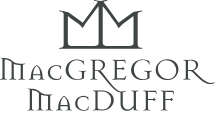The plaid is arguably the most traditional element of a kilt outfit, worn on very special occasions. Historically, the first type of kilt was the Féileadh Mòr or Great Kilt which was essentially a long piece of material, roughly 9 yards long. Half of that material was pleated and belted around the waist and the other half was draped over the shoulder. The great kilt was worn by highlanders in the 16th century but by the late 17th century and early 18th century, the kilt had evolved and the need for the upper half of material had been lost. At this point, kilts became more like what we wear today. The plaid represents the upper half of the great kilt which is why it is seen as a very traditional element to a kilt outfit.

What side do you wear a plaid?
Plaids can be fly or pleated and are draped over the left shoulder. The left shoulder is used because most highlanders would have been right-handed and therefore would have found it easier to drape the plaid over the left shoulder with their right hand. The plaid is secured in place by a plaid brooch. Plaid brooches have become more than just a way to affix your plaid, they are now intricate accessories in their own right and a great way to add a personal touch of style to your kilt outfit. Plaid brooches are available with Celtic patterns, thistles, clan crests, gemstones, and much more.

How do you attach a plaid?
To attach a plaid to your outfit, start by laying it out on a flat surface. Choose which corner you want to have on your shoulder and fold the two adjacent corners inwards and flip the plaid over. Next, you need to get ready to pin it onto your jacket. If your jacket has epaulets, thread the plaid through the one on the left shoulder, if your jacket doesn't have epaulets, just place it over your shoulder. Secure the corner of the plaid that is now on your front, about breast level with your plaid brooch. The plaid should now be hanging down just below the length of your kilt. If secured properly, the plaid will stay in place for your entire event.

Plaids are predominantly worn by grooms and much like a female guest shouldn’t wear white to a wedding, a male guest shouldn’t wear a plaid if the groom chooses to wear one. As mentioned previously, plaids are usually reserved for the most formal occasions so if you are thinking of wearing a plaid, it’s probably a good idea to check the dress code beforehand. These rules don’t apply to pipers as they will often wear a plaid as part of their outfit. You can also wear a plaid with a tartan trews or trousers outfit, but this is less common.

The best time to buy a plaid is at the same time as you buy a kilt. Doing so will allow your kilt and plaid to be made from the same cut of tartan. This means that everything will match up perfectly. Tartans from different mills are often slightly different which may be noticeable if your plaid and kilt are made with tartan from different mills. If you’re thinking of buying a plaid from us and you already have a MacGregor and MacDuff kilt, we will be able to source the same tartan. If it’s a kilt you have bought from somewhere else, we will always do our best to get the best match possible.
If you have any questions about plaids, email info@macgregorandmacduff.co.uk and our team will be happy to help.
